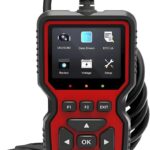Having a reliable OBD2 scanner can empower you to understand your car’s health, potentially saving you hundreds on repairs. Two popular choices are Carista and Carly. This comprehensive comparison delves into their features, pricing, and compatibility to help you decide which is best for your needs.
Carista vs. Carly: Feature Breakdown
Both Carista and Carly offer similar core functionalities, but key differences exist in features and accessibility.
OBD2 Diagnostics: Engine Fault Codes
Both scanners read and clear engine fault codes using the free app version, providing essential information about potential engine problems. However, Carly excels by providing fault code severity levels (very bad, bad, average), offering a clearer picture of your engine’s health. Carista only displays the codes without indicating their urgency.
Manufacturer-Level Diagnostics: In-Depth System Scanning
Beyond the engine, both scanners offer in-depth diagnostics for various systems like ABS, airbags, and transmission. This feature requires a premium subscription for both. Carly provides one free in-depth scan with the lite version, allowing you to test its capabilities. Furthermore, Carly maintains its advantage by displaying fault severity levels for all systems, offering a comprehensive health assessment.
Emissions Check
Both Carista and Carly offer emissions checks in their free versions. Carly supports all car brands globally, while Carista’s compatibility varies; check their website for your specific model.
Car Coding: Customizing Your Car
Carista and Carly enable car customization through coding, allowing you to personalize features like welcome lights and Start/Stop systems. Compatibility varies by car model. While both excel with VW, Audi, MINI, and Skoda, Carly significantly outperforms Carista for BMWs, supporting almost all models, including older ones from 1996 onwards.
Live Parameters: Real-Time Data
Carly provides live engine data, including OBD parameters like RPM in the free version and manufacturer-specific data like turbo boost pressure and oil temperature in the premium version. Carista does not offer this feature.
Additional Features
Carista offers “Advanced Service” for basic maintenance tasks, depending on the car model. Carly provides more comprehensive features like DIY maintenance guides, a used car check to detect mileage manipulation and access vehicle history, and a Digital Garage to store reports for future reference.
Ease of Use
Both scanners and apps are user-friendly. Carly’s interface, particularly for diagnostics, provides a clearer presentation of fault code severity and overall car health, enhancing user experience.
Compatibility
Both scanners work with cars equipped with OBD2 ports. Carly supports most car brands from 2001 onwards for basic features, with exceptions for BMWs (compatible from 1996 with an adapter). Carista’s premium features are limited to specific brands. Both apps are compatible with iOS and Android devices.
Warranty
Carista offers a 2-year warranty on its OBD2 scanner, while Carly provides a lifetime warranty, offering superior long-term value.
Pricing
Carista’s scanner costs $29.99, but its free app features are limited. Premium features require a subscription starting at $9.99 per month. Carly’s scanner costs $69.90 plus shipping, but the free app offers more features, including one free in-depth diagnostic and used car check. Premium features require a yearly subscription starting at $21.96.
Carista OBD2 vs. Carly: The Verdict
Carly emerges as the winner due to its comprehensive features, user-friendly interface, lifetime warranty, and greater value in the free app version. While Carista offers a more affordable entry point, Carly’s added functionalities, especially the detailed fault code analysis and additional features like live data and used car check, justify the higher initial investment.

